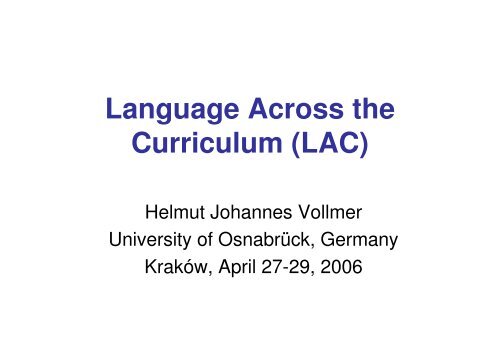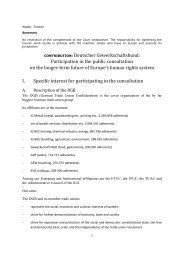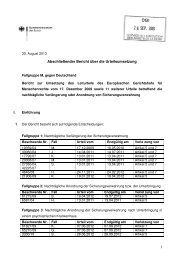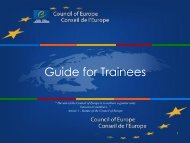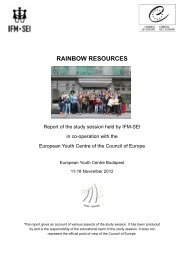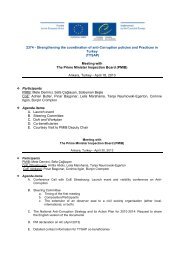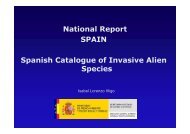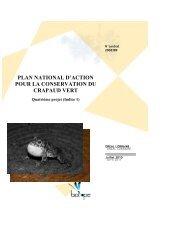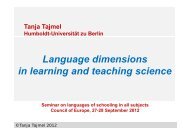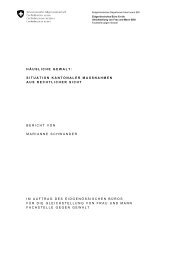Language Across the Curriculum (LAC) - 404 Page not found
Language Across the Curriculum (LAC) - 404 Page not found
Language Across the Curriculum (LAC) - 404 Page not found
Create successful ePaper yourself
Turn your PDF publications into a flip-book with our unique Google optimized e-Paper software.
<strong>Language</strong> <strong>Across</strong> <strong>the</strong><br />
<strong>Curriculum</strong> (<strong>LAC</strong>)<br />
Helmut Johannes Vollmer<br />
University of Osnabrück, Germany<br />
Kraków, April 27-29, 2006
Structure of Presentation<br />
1. Origins of <strong>the</strong> <strong>LAC</strong> concept<br />
2. Eight modes of language use<br />
3. <strong>Language</strong> and Thinking (CALP)<br />
4. <strong>Language</strong> and Learning (Ontario 1984)<br />
5. The basic tenets of <strong>LAC</strong><br />
6. L1 and subject-specific learning: Mutual profits<br />
7. Content and <strong>Language</strong> Integrated Learning<br />
8. <strong>LAC</strong> Extended: An integrated approach<br />
9. <strong>LAC</strong>: From Concept to Policy<br />
2
1. Origins of <strong>the</strong> <strong>LAC</strong> concept<br />
• Origins in Great Britain<br />
• 1975: Bullock Report „A <strong>Language</strong> for Life“<br />
• 1985: Swann Report „Education for All“<br />
• Linking language and learning<br />
• No longer narrowly seen as <strong>the</strong> domain of L1<br />
• Not confined to <strong>the</strong> conventional 4 modes of l.<br />
• Including non-verbal ways of expression<br />
• Handling o<strong>the</strong>r semiotic systems<br />
3
2. Eight modes of human activities<br />
involving language<br />
• Listening: comprehending oral input/intake<br />
• Speaking: constructing meaningful utterances<br />
• Reading: understanding written texts<br />
• Writing: producing written texts/discourse<br />
• Viewing: attending to visual signs/information<br />
• Shaping: using visual means of expression<br />
• Watching: attending to <strong>the</strong> movements<br />
• Moving: using <strong>the</strong> whole body / person<br />
4
3. <strong>Language</strong> and Thinking<br />
• <strong>Language</strong> is more than Communication Skills<br />
• <strong>Language</strong> is linked to <strong>the</strong> Thinking Process<br />
• BICS versus CALP (Cummins)<br />
• Cognitive Academic <strong>Language</strong> Proficiency =<br />
using language as tool, for discourse functions<br />
• Goal: Developing „Conceptual Literacy“<br />
• Solving cognitively demanding tasks in a more<br />
and more de-contextualized manner<br />
• Cognitive-Cultural Variables for school success<br />
5
4. <strong>Language</strong> and Learning<br />
• <strong>LAC</strong> focussus more on learning (than teaching)<br />
• Ontario Ministry of Education, Canada (1984)<br />
Statement of policy (see OHP and Handout):<br />
• „<strong>Language</strong> plays a central role in learning. No matter<br />
what <strong>the</strong> subject area, students assimi-late new concepts<br />
largely through language, that is when <strong>the</strong>y<br />
listen to and talk, read and write about what <strong>the</strong>y are<br />
learning and relate this to what <strong>the</strong>y already know….<br />
..Encouraging all teachers to participate in developing<br />
and practising a school language = “learning“ policy.<br />
6
5. The Basic Tenets of <strong>LAC</strong><br />
• 1. <strong>Language</strong> develops mainly through its<br />
purposeful use (domains to be broadened)<br />
• 2. Learning often involves talking, writing,<br />
shaping and moving (in reaction to perceptions)<br />
• 3. Learning often occurs through speaking or<br />
writing as much as shaping and moving<br />
• 4. <strong>Language</strong> use contributes to (is a prerequisite<br />
for) cognitive development<br />
• 5. <strong>Language</strong> is medium for reflecting learning<br />
7
6. L1/LS education and subjectspecific<br />
learning: Mutual profits<br />
• Necessary: Explicit definition of expected<br />
outcomes in L1 (competencies and standards)<br />
• Transfer of L1 competences into <strong>LAC</strong>:extension<br />
• Functions of language in subject-specific<br />
learning (comprehension/production/interaction)<br />
• Profits for L1 from subject-specific approaches<br />
• Cross-curricular linkages necessary: development<br />
of „internal“ plurilingualism(varieties of L1)<br />
8
Some <strong>Language</strong> Competencies in L1<br />
• Understanding/Interpreting utteracnces/texts<br />
• Linking information from different sources<br />
• Presenting results from studying+analysing<br />
• Embedding, Evaluating, Judging Texts<br />
• Interacting with o<strong>the</strong>rs: construction of meaning<br />
• Production of own texts in a variety of ways<br />
• Reflecting and evaluating own learning process<br />
9
Focus: Subject-Specific<br />
Communicative Competence<br />
• Developing language for academic purposes<br />
(in LS + in all o<strong>the</strong>r subjects)<br />
• Cummins: CALP (as opposed to BICS)<br />
(Cognitive Academic <strong>Language</strong> Proficiency)<br />
• Reading Comprehension as a basis for all<br />
o<strong>the</strong>r linguistic and cultural „skills“<br />
• Specific demands of discontinuous „texts“, of<br />
text-image relations + of social semiotics<br />
10
<strong>Language</strong> for specific purposes<br />
• a. Understanding/interpreting different<br />
layers of meaning = (re)constructing<br />
meaning<br />
(based on different sources of information)<br />
• b. Composing meaning through logical<br />
structuring and networking of concepts<br />
into appropriate utterances and texts<br />
• c.Interacting (online) in <strong>the</strong> negotiation and<br />
joint construction of (subj.-spec.) meaning<br />
11
Discourse Functions<br />
• Linking of (subj.spec.) concepts/networking<br />
• Linking of information units/sentences<br />
• Linking of arguments + support, discussion<br />
• Demands of precision, explicitness,<br />
rationality, concrete and abstraction<br />
• Differences between Definition, Assertion,<br />
Description, Illustration, Exemplificaiton etc.<br />
• Overall structure (purpose, audience,genre)<br />
12
Mediation competence<br />
• Mediation=translation=rephrasing/restructuring<br />
• for different groups of peers<br />
• for <strong>the</strong> teacher (as a representative of <strong>the</strong><br />
public and/ or scientific community)<br />
• for a lay audience (parents, school, public...)<br />
• for „experts“ from outside, from field/discipline.<br />
This leads to increasing degrees of participating<br />
in different discourses + disc. communities<br />
13
Application to educational<br />
standards<br />
• Subject-specific communication has been<br />
accepted and incorporated into <strong>the</strong> compepetence<br />
model of many subjects (particular-ly<br />
<strong>the</strong> sciences, geography, history)<br />
• In Germany, Biology and Chemistry are in <strong>the</strong><br />
process of spelling out how <strong>the</strong>y understand<br />
„Fachkommunikation“, how to teach + test it.<br />
• Cooperation between linguists, language<br />
teachers and subject teachers<br />
14
7. „Bilingual“ Education / Content and<br />
<strong>Language</strong> Integrated Learning (CLIL)<br />
• Broad label for many different initiatives/types<br />
• Functions: Transitory, Maintenance, Enrichment<br />
• From Kindergarten to higher education<br />
• Use of ano<strong>the</strong>r language (than LE/L1) for<br />
instruction (L2, for migrants kids L3)<br />
• The focus is on content, topic, subject-matter<br />
and language as a tool (instead of form)<br />
• Special forms: Immersion, dual lang. educat.<br />
15
Features of Bilingual Education/CLIL<br />
• L2/L3...Ln as language of instruction<br />
• L2/L3...Ln as language of thinking/cognition<br />
• <strong>Language</strong> as a tool, <strong>not</strong> a goal in itself<br />
• <strong>Language</strong> support: functional <strong>not</strong>ions, speech<br />
acts, rhetorical structures, text+discourse types<br />
• Semantic networking, linking terms/expressions<br />
• Developing subj.-spec. Comm. Comp. in L2/L3<br />
• Insertion of language „islands“ (if necessary)<br />
16
Goals of Bilingual Education<br />
• In Europe: normally enrichment, maintenance<br />
• Often: socio-cultural integration<br />
• Sometimes connected with or leading to<br />
language loss and language shift<br />
• Bilingual schooling: Developing a second<br />
system of communication for participation<br />
• Saddest case: „double semilingualism“ (where<br />
nei<strong>the</strong>r L1 nor L2 is fully developed as a tool)<br />
17
Some Advantages of CLIL:<br />
• Restructuring <strong>the</strong> subject matter in basic terms,<br />
conceptualising and thus verbalising more<br />
consciously, more explicitly, in smaller units,<br />
linking it to prior (everyday) knowledge<br />
• Linguistic struggle/revolving helps semantic<br />
processing+thus understanding and storage<br />
• More awareness and consciousness-raising as<br />
to language + thinking, diversity, pluriling.<br />
• More linguistic and mental „creativity“<br />
18
Data from <strong>LAC</strong>/CLIL research<br />
• Example 1: see slide no 22<br />
<strong>Language</strong> used in a Think-Aloud Process<br />
• Example 2: see Handout<br />
<strong>Language</strong> used for negotiating meaning<br />
• Example 3: see Handout<br />
<strong>Language</strong> used for editing one‘s own text<br />
19
Source: DFG project “Subject-specific<br />
learning and (second) language education:<br />
Cognition, Communication, Cooperation”<br />
(Prof. Vollmer, Osnabrück, Germany)<br />
• Comparison of monolingual and bilingual<br />
learners in grade 10 (subject: Geography)<br />
• Development of tasks for a competence test<br />
• Fokus: written discourse competence with<br />
• Processes: Think-Aloud-Protocols (individ.)<br />
• Processes: Collaborative task solutions (pairs)<br />
• Processes: First version, Edited version<br />
20
Learner‘s answer to a task on <strong>the</strong><br />
distribution of <strong>the</strong> tropical rain forest<br />
• “Tropical rainforest can be <strong>found</strong> around<br />
<strong>the</strong> equator of our world. A few degree<br />
more or less doesn‘t matter. Tropical<br />
rainforest is about 0°. Within <strong>the</strong> equator<br />
are countries like Brasil, Columbia, part of<br />
Mexico (rainforest), central Afrika<br />
countries (Kongo …) and in <strong>the</strong> east<br />
Indonesia or Thailand.”<br />
21
Example 1: Data taken from a Think-Aloud-Protocol<br />
Transkript 1012 Karen 1.b<br />
1. (1 s) Ähm <strong>the</strong> . precipitation (2s)<br />
2. [(schreibend) <strong>the</strong> precipitation (3 s) hmmm]<br />
3. (1 s) [(d) schwankt.]<br />
4. (1 s) [(leise) Hm.] . .<br />
5. Precipitation is (1 s) high . in . April (1 s) August and . October<br />
6. (2 s) The pr- <strong>the</strong>re is much precipitation<br />
9. [(schreibend) it´s never . . under (1 s) h- h- . a hundred (1 s)<br />
millimetres (2 s) millimetres per (1 s) per . . square . metre (1 s)<br />
ähmm (1 s) but in August and October] [...] [(schreibend) (2 s)<br />
<strong>the</strong> precipitation (1 s) climbs up (3 s) to]<br />
10. (1 s) two hundred (1 s) tw- . nn- two hundred thirty.<br />
11. . Yes. (1 s)<br />
22<br />
12. (schreibt, 1 s)
8. <strong>LAC</strong> Extended:<br />
An Integrated Approach<br />
• 1. Relating L1/LS/LE to FLE or SLE: „Bildung“<br />
• 2. Developing subject-specific language competence<br />
in each subject and across all of <strong>the</strong>m<br />
• 3. Relating <strong>the</strong> learning of <strong>the</strong> first FL to that of<br />
learning o<strong>the</strong>r/fur<strong>the</strong>r FLs<br />
• 4. Relating FLE to Heritage <strong>Language</strong> Educat.<br />
• 5. Using a FL/L2/L3 as a language of<br />
instruction („Bilingual Education/CLIL)<br />
23
Aspects of „Bildung“<br />
• Unfolding of subjectivity + cultural realisation<br />
• Basis for self-definition and self-regulation<br />
• Bildung = „What I always have with/on me“ -<br />
„What nobody can take away from me“<br />
• Potential for leading a happy+successful life<br />
• (Re)Socializing=Giving „things“ back: functioning<br />
/ participating professionally + socially<br />
• Basis for continuous/life-long learning+inclusion<br />
24
<strong>Language</strong> Education as a whole<br />
• Need for a larger framework to describe <strong>the</strong> relative<br />
contributions of different types of formal and informal<br />
language education: „Gesamtsprachliche Bildung“<br />
• Comprehensive goal setting for language education<br />
- organising thinking and learning<br />
- self-regulation, self-realization, self-reflection<br />
- socialising with o<strong>the</strong>rs,constituting meaningful relation<br />
- living and working toge<strong>the</strong>r: x discourse communities<br />
- participating in shaping of domains/society/democracy<br />
- living happily, successfully, peacefully<br />
25
„Gesamtsprachliche Bildung“<br />
(quote from Frederking/Hu/Legutke/Oomen-Welke/Vollmer 2004: 95)<br />
• „The overriding goal is to develop an integrated<br />
language education which is based on prior<br />
knowledge and capacities of <strong>the</strong> children, unfolding<br />
<strong>the</strong>se fur<strong>the</strong>r, enriching <strong>the</strong>m, linking <strong>the</strong>m<br />
toge<strong>the</strong>r so as to lay <strong>the</strong> basis for continuous, lifelong<br />
learning and for competent participation into<br />
societal decision-making processes. In doing so<br />
certain competencies become important which<br />
can be summarized as abilities of handling language<br />
in an understanding, productive and creative<br />
as well as in an analytical-reflexive manner“.<br />
26
Some Core Competencies<br />
• „Knowledge base“ (as defined by cognitive<br />
scientists)<br />
• „Dispositions“ (for future performance/learning)<br />
• Potentials (acquired level of achievement)<br />
• Set/array of „knowledge, abilities, skills,<br />
attitudes, experinces, motivations“ (Weinert)<br />
necessary for mastering new challenges<br />
• Threshold <strong>the</strong>ory: „plateau“/spilling over<br />
27
A Comprehensive Literacy Model<br />
• Listening Comprehension Competence<br />
• Auditory-Visual Competence<br />
• Reading Competence<br />
• Writing Competence<br />
• Speaking Competence<br />
• Symbolic Decoding/Semiotic Competence<br />
• Media Competence<br />
• Literary and Aestetic Competence<br />
• Functional-Pragmatic Competence<br />
• Intercultural Competence<br />
• <strong>Language</strong> Learning Competence<br />
• Metalinguistic Competence/<strong>Language</strong> Awareness<br />
28
A. Issues for Research Involved<br />
• 1. Developing a larger <strong>the</strong>oretical framework<br />
for linking LS/LE, FLE/SLE, HLE, Ln<br />
• 2. Comparing and integrating different models<br />
of language acquisition + lang. use<br />
• 3. Analyzing relations between minority and<br />
majority languages and <strong>the</strong>ir learning<br />
• 4. Describing modes of lang.prof.: BICS vs.<br />
CALP, discourse comp.=ways of participating<br />
• 5. Identify specifics of bilingual/dual l. learning<br />
29
B. Issues for learning involved<br />
• (1.) Linking language(s) as subject(s)<br />
(LE with FLE/SLE or FLE + several FLs):<br />
Comparing aspects of meaning, form, pragmatics,<br />
disc. conventions, types + patterns<br />
• 2. Extending, diversifying, applying and<br />
specialising LS/LE through subject-specific<br />
lang. use (basis for forming multiple identities)<br />
• 3. Developing a second system of<br />
communication + participation through CLIL<br />
30
C. Issues for Teaching Involved<br />
• 1. Identifying ways of linking LS/LE with o<strong>the</strong>r<br />
areas/subjects of explicit language teaching<br />
• 2. Taking special care of disadvantaged/ migrant<br />
children (differentiation, heterogeneity)<br />
• 3. Using prior „knowledge“ in FLE (MSK-Did.)<br />
• 4.Identifying components, levels and specific<br />
(contextualized) exercises for developing<br />
subject-specific communicative competence<br />
• 5. Streng<strong>the</strong>ning <strong>the</strong> role of language support<br />
31<br />
and language-mediated learning within CLIL.
9. <strong>LAC</strong>: From Concept to Policy<br />
• Difficulties+Responsibilities in realising concept<br />
• A whole school approach: a school language<br />
policy means a school learning policy!<br />
• <strong>LAC</strong> as an integrated framework for l./l. policy<br />
• Teacher roles + attitudes: Rethinking, retraining<br />
• Leading role of <strong>the</strong> principal + of administration<br />
• Planning on <strong>the</strong> Local, Provincial, National level<br />
• Summary and Persepctives (1) and (2)<br />
32
Perspectives (1)<br />
• 1. Identifying dimensions of subject-specific<br />
communication<br />
• 2. Spell out <strong>the</strong> academic language<br />
component(s) in non-linguistic subjectmatter<br />
learning and teaching<br />
• 3. Explicitly draw on already existing<br />
language skills/knowledge/competencies<br />
(built up through LE, FLE, or o<strong>the</strong>r subjects.<br />
33
Perspectives (2)<br />
• 4. Experiment with L2/L3 as <strong>the</strong> language of<br />
thinking and learning<br />
• 5. Experience <strong>the</strong> unity of conceptualising<br />
and verbalising.<br />
• 6. (Re-)Structure a topic /a subject matter in<br />
basic terms, linking it to prior knowledge and<br />
to non-verbal forms of representation<br />
• 6. Insist on <strong>the</strong> development of CALP across<br />
all subjects within <strong>the</strong> school curriculum.<br />
34
THANK YOU!<br />
35


